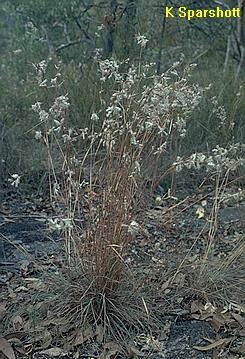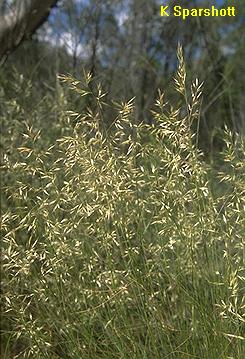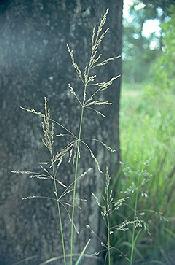|
[Front Page] [Features] [Departments] [Society Home] [Subscribe]

Use of Native Grasses in Landscaping
Bev Courtney
Australian grasses come in a variety of sizes, shapes and colours and make excellent garden subjects, especially when their tufting habit is used as a contrast to the bushy habit of herbaceous plants and shrubs. I've been growing native grasses for some years now. and feel confident in making some comments on their growth and maintenance.
Grasses are at their visual best in their first year of growth. All leafy stems are green and vigorous. At the end of the flowering season, all flowering stems and some central leafy growth will die off, leaving a mottled green/straw-coloured appearance which, in some landscaping projects, would be regarded as unattractive. In these situations, the tufts can be slashed or cut with secateurs to within an inch or so of the ground. This will promote new, vigorous, green growth within a few days. After a few years, the tuft may die out in the centre and complete replacement with new plants may be necessary. If multiplication by self-seeding is required, then cutting back should be done after seed has dropped.
Tufting species grow as single. discrete tufts. which increase in size by producing new growths at the edges. Stoloniferous or rhizomatous species spread by producing vigorous horizontal outgrowths, either above or below ground, which produce new tufts at nodes along their length. Tufting species are more suitable for landscaping. Stoloniferous species can quickly overrun an area and spread into adjacent areas where they may not be wanted. Complete removal can be extremely difficult.
Some species are autumn/winter growing (AW). They usually germinate naturally with the autumn rains and grow through winter, flowering in spring. Generally flowering has finished and seed has dropped by early to mid summer. Other species (SS) germinate in spring as the ground warms up and grow and flower through summer and into the autumn. Seed drops in autumn. In winter they are usually dormant. with new growth commencing in early spring.
Species I can recommend are listed below. Usually I try to keep to species which are locally indigenous (to Melbourne), but there are a couple of non-locals which just can't be ignored.
 |
|
 |
| Cymbopogon obtectus, Silky heads (left) and Notodanthonia longifolia, Long-leaved wallaby grass (right). Photos: (Kym Sparshott) |
Themeda australis - Kangaroo Grass (Sometimes also called Themeda triandra) SS. Large tussock to 1m high and wide. Flowering stems are erect to weeping. Flower heads are attractive. green tinged purplish, turning brown at maturity. Cutting back in early spring immediately promotes vigorous, new, green growth.
Poa species (Tussock Grasses)
- Poa labillardieri - Common Tussock Grass AW. Large tussock to 1 m high and wide. Colour varies. Most forms have attractive. blue-green leaves. Flower stems are fine. open panicles and may be erect or weeping.
- Poa morrissii - Velvet Tussock Grass AW. Medium, erect tussock, with hairy stems giving a soft greyish appearance. Flower stems grow to 1 m high. Clumps increase slowly in width and can become very tangled and flattened if not regularly cut back. (I suspect neighbours cats may have something to do with this.)
- Poa clelandii - Tussock Grass AW. Medium, erect tussock with fine, bright green leaves and flower stems to 50cm high. Flowers are often purplish.
Wallaby Grasses. A number of wallaby grasses occur locally. They are generally small to medium tussocks, although some may have flower stems up to 1 m high. All are autumn/winter growers (AW). Most flower heads are green and white with attractive, purplish tinges when they first open. As flowers mature they turn straw-coloured and fluffy. Recommended species are:
| |
Reclassification of Wallaby Grasses |
| |
In 1996/97, H.P.Linder and G.A.Verboom from the Bolus Herbarium, Cape Town, (Telopea 6(4) and 7(3)) recognised the distinction between Australian species of the wallaby grasses and Danthonia, which they regarded as being restricted to the Americas, Europe, Africa and Asia.
As a result of this work, the Australian species formerly included in Danthonia were reclassified by Linder and Verboom into four genera....Austrodanthonia, Notodanthonia, Joycea and Rytidosperma.
Advice from the NSW Herbarium indicates that this re-classification has been generally accepted although it is considered that the new classification is not entirely satisfactory and may be subject to revision in the future. |
- Austrodanthonia geniculata - Kneed Wallaby Grass (syn. Danthonia geniculata). Small tussock to 40cm usually producing a large number of flowering stems. Ideal for mass planting. eg at the front of a garden bed.
- Austrodanthonia bipartita - Wallaby Grass (syn. Danthonia linkii var.linkii) . Medium tussock, interesting only because of the hairy, blue-green leaves. Flower stems up to1m.
- Austrodanthonia caespitosa - Common Wallaby Grass (syn. Danthonia caespitosa). Medium tussock. Also blue-green in colour but. in addition. foliage often develops pinkish tinges.
- Austrodanthonia sp. - Tall Wallaby Grass (syn. Danthonia procera). A locally rare species. Bright green leaves with flowering stems to 1.5m high. Flowers are attractive. with orange anthers, but this species doesn't seem to produce many flower stems.
- Austrodanthonia setacea - Bristly Wallaby Grass (syn. Danthonia setacea). Two forms exist in our area. One form grows on heavier soils and is a medium tussock with large flower heads, deep purple when emerging The other is much liner in all respects and seems to be confined to sandy soils.
Austrostipa species (Spear Grasses). A number of spear grasses exist locally. They generally have tall, leathery flowering stems, but the plants are smallish tufts with not much leafy growth. They appear insignificant when not in flower but come into their own at flowering time especially if closely grouped. One species which is beautiful when flowering is:
- Austrostipa elegantissima - Feather Spear Grass (syn. Stipa elegantissima). Although leaf growth is often sparse and spindly, if mass-planted it would look superb at flowering time.
Two non-local species
- Cymbopogon ambiguus - Lemon Grass SS. Large tussock to 1 m high and wide. Not a local species but well worth growing for the blue-green foliage and attractive, silvery-green flower-heads. Leaves are lemon-scented.
- Dichanthium sericeum - Silky Blue-grass SS. Medium, erect tussock with flower stems to 1 m. Foliage colour is blue-green with purplish tinges, and several clumps look beautiful when close planted. Unfortunately not local to our area. but this is one species I can't resist.
 |
 |
|
Austrostipa aristiglumis (left); Poa labillardieri (right)
(Kym Sparshott)
|
In the garden I generally allow the smaller grass species such as wallaby grasses to self-seed where they like, and this helps to provide the "natural bush" look I want to achieve. I don't cut them back after flowering, as there are usually too many and I like the look of the dried flower stems and heads, which give a seasonal transition from spring through summer and into autumn. An added bonus is that birds seem to relish collecting the dead stems at nesting time. Treated this way. these species tend to behave as short-term perennials and die completely after 2 - 3 years.
Each year I go through the garden. completely removing the dead and the worst-looking of the still-living, so that there are always new seedlings and middle-aged plants looking reasonably attractive.
The large tussocks are best if rejuvenated every 1 or 2 years. I grow fewer of these because they take up more room, and I treat them more as single specimens rather than to provide a bush effect. I would love to have the area to be able to plant large swards of each species as I feel that they would look spectacular when in flower.
From the newsletter of the Garden Design Study Group, November 1995.

[Front Page] [Features] [Departments] [Society Home] [Subscribe]
Australian Plants online - September 2001
Association of Societies for Growing Australian Plants
|